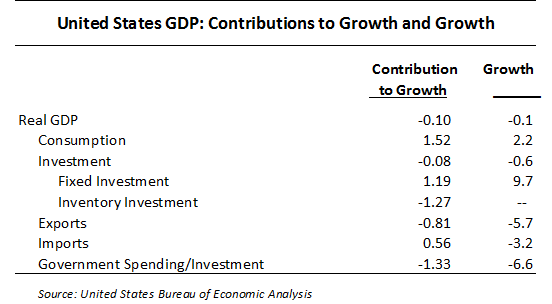CERF Blog
Fourth quarter United States GDP contracted by about $5 billion dollars, which is 0.1 percent negative growth annualized. This is after 3.1 percent growth in the third quarter which was the strongest quarter in 2013. The largest drivers of the fourth quarter decline were a contraction in government spending of 6.6 percent and a change of inventory investment down by $40 billion. The change in government spending was driven by a massive contraction in defense expenditures. Given the massive expansion of government expenditures in the third quarter, I wonder if some defense purchases were moved forward from quarter four to quarter three. Trade also detracted from GDP growth with a net overall contribution to GDP of negative 0.25 percent.
Consumption expenditures grew at 2.2 percent in quarter four, compared with 1.6 percent in quarter three. Fixed investment grew 9.7 percent, compared with 0.9 percent in quarter three.
I put a table with relevant data here:
Forecasting GDP is hard enough, but the volatility makes the task even harder. The drivers of the volatility in recent quarters have been inventory investment and government, where the contribution to GDP growth each has changed sign twice in the last two quarters.
I do not actually try to forecast the volatility in GDP, our GDP growth forecast is purposely “smoother” than recent history. This makes our forecast easier to explain to our clients, and reduces the risk of a large forecast error, particularly the error of getting the sign wrong. This strategy did not help this time, as our forecast was 1.5 percent for fourth quarter.
What we try to do with our forecasts is to be closer to the truth than our competition. Our competition is the Wall Street Journal consensus of forecasters, a survey of 50 of the top forecasters from around the country. The consensus forecast was 1.6 percent. We were slightly closer to the reported truth than consensus.
The partner to the numerical calculation of the forecast is the story we tell our clients. From this point of view, we have been more accurate than our competitors. We have cautioned our clients about underlying weakness in the economy for many years now, in fact, ever since the fall of Lehman Brothers in September 2008. The new quarter four data provide evidence that weakness still exists.
Residential investment has been strong now for five quarters in a row, and home prices are indicating a gradual housing market comeback. This is good, but the housing comeback will take time and it might never reach pre-recession highs. This probably means some of those construction workers will never again work in that field.
Our January 10 forecast for 2013 quarter one was 1.2 percent, weaker than our forecast for quarter four of last year. With the new quarter four data, I will rerun the model, and while the negative contribution to GDP from government expenditure will likely need to be viewed as a one-time hit, the slowdown in inventory investment and export growth will likely be viewed as indication of weaknesses that will continue to exist in the this quarter.


